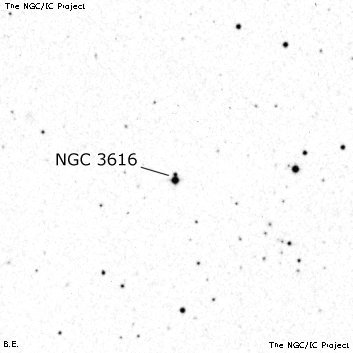NGC/IC Project Restoration Effort
(This is a very very beta version)
NGC3616


Basic Information
Location and Magnitude
Right Ascension: 11:18:8.6
Declination: +14:45:58
Constellation: LEO
Visual Magnitude:
Historic Information
Discoverer: Herschel W.
Year of discovery: 1784
Discovery aperture: 18.7
Observational
Summary description: eF, pL
Sub-type: NF
Corwin's Notes
=====
NGC 3616 is probably lost. It may be one of the stars I've noted in the
position table, but I'm not sanquine about the possibility.
Found 8 April 1784 by WH, and never seen again by anyone, he published it as
merely "eF, pL; easily ver[ified with] 240[power]." The star I chose decades
ago when I was young and naive is surely not WH's object, and I am pretty sure
that the double star close to WH's place is not it, either. Neither of these
is "pretty large", and while the double star might appear somewhat nebulous on
a poor night, I don't see how WH could have seen anything but "vS" or "eS" for
it.
In the sweep, he is not much more forthcoming: "Excessively F, pL; some
doubts were removed by putting on 240. 70 (theta) Leonis f 4[m] 0[s], s 0[d]
41[arcmin]." CH's reduction to 1800 is "RA 11h 7[m] 44[s] PD 74[d]
10[arcmin]" which is very close to the position re-reduced with a modern
position and proper motion for the comparison star.
WH also had trouble with the previous class III object in the same sweep (NGC
3498, which see), though not with the immediately preceding NGC 3596 (= II
102). It's possible that the declination is off, but that would pull this
one object out of the zone of all the other nebulae found this same night. I
would rather think that the RA is out, but that, too, is a problem because of
the solidity of WH's observation with respect to NGC 3596 (Dreyer notes, "In
the sweep, it is 3.2m f, 3' s of II. 102 [= N3596], the place of which is
correct.").
Still, it's a field rich in galaxies, so we may yet dig this out. But after
examining the sweep, I am less confident than ever about that.



